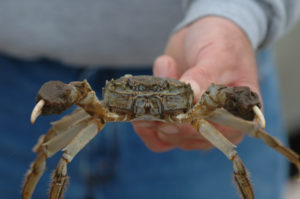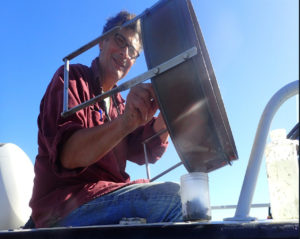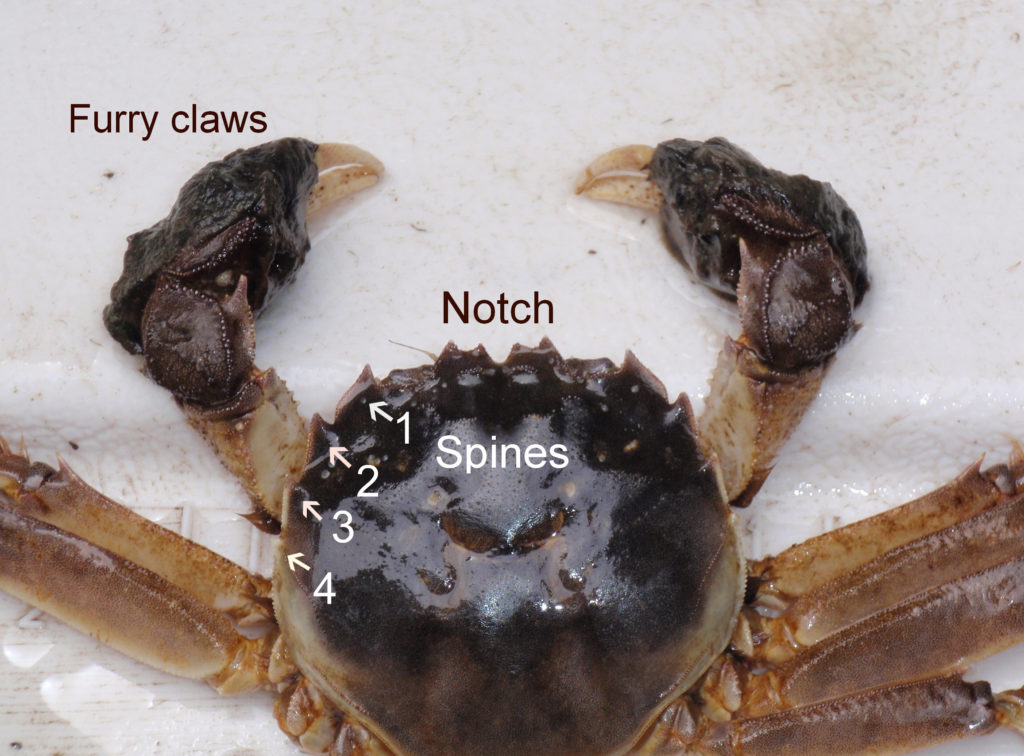
A Chinese mitten crab found in Chesapeake Beach, Md., in 2007. Chinese mitten crabs are most recognizable by their brown, spiny shells and furry “mittened” claws. (Credit: SERC)
by Kristen Minogue
An army of invading crabs has disappeared. But scientists are skeptical about whether they’re gone for good, or just hiding. As warmer temps lure people onto the water, Smithsonian scientists are asking boaters to report any sightings of the elusive Chinese mitten crab.
In 1992, a team of fishermen unexpectedly caught a Chinese mitten crab while trawling for shrimp in southern San Francisco Bay. From there, sightings of the brown, furry-clawed crustaceans exploded. In 1998, nearly three quarters of a million appeared in the North Bay alone. The mitten crabs threatened to collapse river banks with their burrows and made fishing nearly impossible in some places, as they clogged gear, stole bait or ate trapped fish.
“It was spectacularly abundant. A true outbreak,” said Greg Ruiz, a biologist with the Smithsonian Environmental Research Center (SERC). “And it clogged the water intakes. Water is the economy in California.”
Mitten crab numbers remained high through 2005. And then they vanished. Chinese mitten crabs haven’t been seen in California since 2010.

Marine biologist Greg Ruiz tracks marine invasive species in Chesapeake Bay, San Francisco Bay and other coasts. (Credit: Ross Whippo/SERC)
A more low-budget version of the story played out on the East Coast. Over a hundred mitten crabs have shown their claws in the Hudson River since 2007. Dozens more turned up in Chesapeake Bay, Delaware Bay and New Jersey. But they haven’t been seen Maryland since 2009. And in the Hudson—the only East Coast site where scientists found them breeding—the reports stopped in 2014.
“‘Are they still there?’ This is the question,” said Ruiz. “I don’t know the answer.”
“You’d think with all of that water, someone should be seeing something,” said biological technician Darrick Sparks.
Sparks works with the center’s Marine Invasions Lab, which Ruiz heads. Shortly after the crabs began appearing on the East Coast, Sparks and fellow technician Brian Steves helped the center set up a mitten crab hotline and Website for anyone who spotted a mitten crab to report it. They collected dozens of reports from 2005 through 2009. But after 2009, reports began tapering off and then virtually disappeared.
At first glance, this could be a rare victory in the fight against invasive species. Chinese mitten crabs are native to East Asia and are considered a delicacy in Chinese cuisine. But abroad, they’ve earned a reputation as one of the world’s worst invaders for clogging water systems, disrupting fishing and destabilizing river banks. Their arrival in the U.S. likely came accidentally (through the ballast water of ships) or deliberately (to sell in seafood markets). If they’re truly gone, the communities along these waterways could have dodged a very expensive bullet.
But there’s another more troubling possibility: The mitten crabs could be slipping under the radar. According to Sparks, there haven’t been many focused searches for mitten crabs anywhere in the U.S. Most reports have come from boaters or fishers who caught the crabs accidentally.
This year, SERC biologists are looking to double down their efforts. In a last-ditch attempt to root out any hidden crabs, they’re reaching out to boaters, fishers, scientists and government agencies throughout the U.S. asking them to report sightings of Chinese mitten crabs. They’re focusing on three regions: San Francisco Bay, Chesapeake Bay and the Hudson River.
“The goal is to be able to put the word out and shake the trees and see if anything falls out,” Ruiz said.
They’ve already found one mitten crab near Yonkers, New York. A waterman on the Hudson River caught it in a crab pot this May and reported it to the New York State Department of Environmental Conservation.
If you are (un)lucky enough to catch a mitten crab in a net, a trap, or anywhere else, don’t throw it back alive. Here’s what to do:
- Take a close-up photo.
- Note the location where you found it.
- Freeze it, put it on ice, or (last resort) preserve it in rubbing alcohol.
- Report your discovery to the Mitten Crab Watch Website at https://mittencrab.nisbase.org or by calling 443-482-2222.



Why freeze it or preserve it? Is it needed it for research?couldn’t a person catch it, photograph it as requested, note where it was caught, and then eat it? Are they edible?
That’s a good question. The Chinese mitten crab is considered a delicacy in many cultures; however, it’s important to be cautious about eating it. Since the crabs are able to survive in a wide array of habitats, knowing where the crab came from is critical. Mitten crabs are known to inhabit polluted waters and have the ability to uptake heavy metals into their tissue, like mercury, lead, and cadmium. Some have also been found to contain contamination from both dioxin (polychlorinated dioxins and polychlorinated dibenzofurans) and PCB (polychlorinated biphenyls).
In addition, the crab is listed under multiple state, federal, and foreign regulations and has been identified as a species of serious concern. Specifically, under the U.S. Lacey Act, it is unlawful to import, export, sell, acquire, or purchase Chinese mitten crabs. A misdemeanor offense carries a fine of up to $100,000 for individuals and $200,000 for organizations.
Here are a few additional resources if you’d like to learn more:
Mercury Burdens in Chinese Mitten Crabs: https://www.sciencedirect.com/science/article/pii/S0269749104002817?via%3Dihub
Dioxins, PCBs and Heavy Metals in Chinese Mitten Crabs: https://www.ncbi.nlm.nih.gov/pubmed/25434274
Lacey Act: https://www.fws.gov/international/laws-treaties-agreements/us-conservation-laws/lacey-act.html
Amendments and Fines for Lacey Act: https://www.fws.gov/laws/lawsdigest/lacey.html